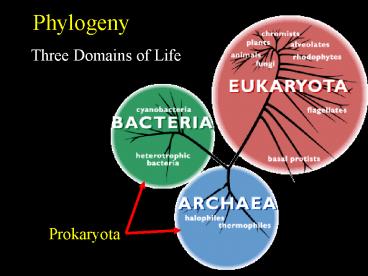Phylogeny - PowerPoint PPT Presentation
1 / 10
Title:
Phylogeny
Description:
a palm tree representing the plants, a spider, one of the animals, and ... is a micrograph of the virus that causes tobacco mosaic disease in tobacco plants. ... – PowerPoint PPT presentation
Number of Views:71
Avg rating:3.0/5.0
Title: Phylogeny
1
Phylogeny
Three Domains of Life
Prokaryota
2
The Eukaryota Fungi, Protists, Plants,
Animals...
The Eukaryota include the organisms that most
people are most familiar with - all animals,
plants, fungi, and protists. They also include
the vast majority of the organisms that
paleontologists work with. Although they show
unbelievable diversity in form, they share
fundamental characteristics of cellular
organization, biochemistry, and molecular
biology. unicellular organisms such as algae
3
- Shown here, clockwise from upper left
- a dinoflagellate,
- a single-celled photosynthetic protist,
- a palm tree representing the plants,
- a spider, one of the animals, and
- a cluster of mushrooms representing the fungi.
4
The Bacteria
Bacteria are often maligned as the causes of
human and animal disease (like this one,
Leptospira, which causes serious disease in
livestock).
5
Bacteria are Essential to Life
- Certain bacteria, the actinomycetes, produce
antibiotics such as streptomycin and nocardicin - others live symbiotically in the guts of animals
(including humans) or elsewhere in their bodies, - or on the roots of certain plants, converting
nitrogen into a usable form. - Bacteria
- put the tang in yogurt and the sour in sourdough
bread - bacteria help to break down dead organic matter
- bacteria make up the base of the food web in
many environments. - Bacteria are of such immense importance because
of their extreme flexibility, capacity for rapid
growth and reproduction, and great age - the
oldest fossils known, nearly 3.5 billion years
old, are fossils of bacteria-like organisms.
6
Bacteria Fossil Record
The picture above is a short chain of
cyanobacterial cells, from the Bitter Springs
Chert of northern Australia (about 1 billion
years old). Very similar cyanobacteria are alive
today in fact, most fossil cyanobacteria can
almost be referred to living genera.
Compare this fossil cyanobacterium with this
picture of the living cyanobacterium
Oscillatoria
7
The Archaea - Life's extremists. .
.
Finding Archaea The hot springs of Yellowstone
National Park, USA, were among the first places
Archaea were discovered
above is Octopus Spring
8
and here is Obsidian Pool. Each pool has
slightly different mineral content, temperature,
salinity, etc., so different pools may contain
different communities of archaeans and other
microbes. The biologists pictured above are
immersing microscope slides in the boiling pool
onto which some archaeans might be captured for
study.
9
Viruses
A fourth group of biological entities, the
viruses, are not organisms in the same sense that
eukaryotes, archaeans, and bacteria are. They
are, however, of considerable biological
importance. Viruses have not been found in the
fossil record
10
Viral micrographs
To the left is an electron micrograph of a
cluster of influenza viruses, each about 100
nanometers (billionths or 10-9 of a meter) long
both membrane and protein coat are visible. On
the right is a micrograph of the virus that
causes tobacco mosaic disease in tobacco plants.































